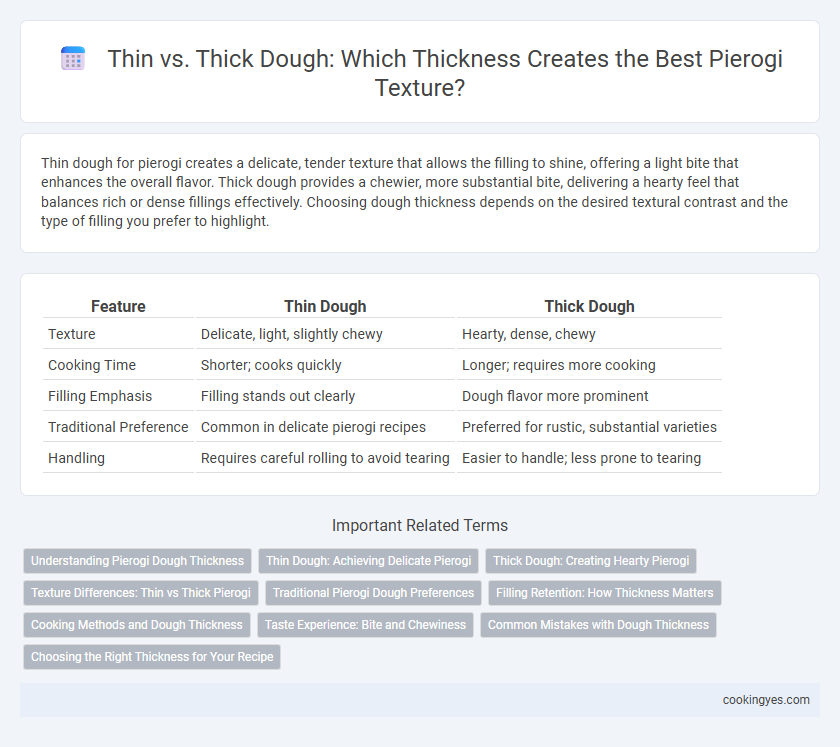Thin dough for pierogi creates a delicate, tender texture that allows the filling to shine, offering a light bite that enhances the overall flavor. Thick dough provides a chewier, more substantial bite, delivering a hearty feel that balances rich or dense fillings effectively. Choosing dough thickness depends on the desired textural contrast and the type of filling you prefer to highlight.
Table of Comparison
| Feature | Thin Dough | Thick Dough |
|---|---|---|
| Texture | Delicate, light, slightly chewy | Hearty, dense, chewy |
| Cooking Time | Shorter; cooks quickly | Longer; requires more cooking |
| Filling Emphasis | Filling stands out clearly | Dough flavor more prominent |
| Traditional Preference | Common in delicate pierogi recipes | Preferred for rustic, substantial varieties |
| Handling | Requires careful rolling to avoid tearing | Easier to handle; less prone to tearing |
Understanding Pierogi Dough Thickness
Pierogi dough thickness significantly impacts texture, with thin dough yielding a delicate, tender bite that highlights the filling, while thick dough offers a chewier, more substantial mouthfeel. Optimal pierogi dough is typically rolled to about 1-2 millimeters, balancing pliability and strength to prevent tearing during cooking. Understanding the interplay between dough thickness and filling moisture ensures pierogi maintain structural integrity and deliver the desired eating experience.
Thin Dough: Achieving Delicate Pierogi
Thin dough enhances pierogi texture by creating a delicate, tender wrapper that complements the filling without overpowering it. Maintaining a thickness of approximately 1-2 millimeters ensures the dough cooks evenly while remaining pliable and light. Optimal thinness allows for a perfect balance between structural integrity and melt-in-the-mouth softness, elevating the overall eating experience.
Thick Dough: Creating Hearty Pierogi
Thick dough for pierogi provides a hearty and satisfying texture that complements rich, robust fillings like sauerkraut, potato, or meat. This dough thickness creates a chewy outer layer that holds up well during boiling and frying, preventing the pierogi from bursting or becoming overly delicate. Opting for thick dough enhances the overall eating experience by balancing structure and flavor, making each bite substantial and comforting.
Texture Differences: Thin vs Thick Pierogi
Thin pierogi dough results in a delicate, tender texture that allows the filling's flavor to stand out, offering a lighter bite with a slight chewiness. Thick pierogi dough provides a hearty, chewy texture that adds substantial body and a rustic feel, often balancing richer or heavier fillings. Texture differences between thin and thick dough significantly affect the overall eating experience, with thin dough emphasizing filling prominence and thick dough contributing to a more robust mouthfeel.
Traditional Pierogi Dough Preferences
Traditional pierogi dough favors a thin thickness to achieve a delicate yet pliable texture, allowing the fillings to shine without overpowering bite. Thin dough preserves the tender, slightly chewy consistency prized in authentic Polish pierogi, ensuring the dumplings remain soft after boiling or frying. Thick dough tends to result in a doughier texture that can mask the flavor of classic fillings like potato, cheese, or sauerkraut.
Filling Retention: How Thickness Matters
Pierogi dough thickness significantly impacts filling retention, with thinner dough providing a delicate texture but higher risk of rupture during boiling, leading to potential filling loss. Thicker dough offers more robustness, effectively sealing in moist or chunky fillings and preventing leaks, yet may result in a chewier texture that overshadows the filling's flavor. Optimal dough thickness balances durability and tenderness, ensuring the pierogi holds its filling securely while maintaining a pleasant bite.
Cooking Methods and Dough Thickness
Thin pierogi dough results in a delicate, tender texture that cooks quickly through boiling or steaming, allowing the filling's flavor to stand out. Thick dough offers a chewier, heartier bite, often preferred for pan-frying or baking, where it crisps on the outside while maintaining a soft inside. Choosing the right dough thickness directly impacts cooking time and final texture, making it essential to match thickness with the intended cooking method.
Taste Experience: Bite and Chewiness
Pierogi dough thickness significantly impacts the taste experience by altering the bite and chewiness; thin dough offers a delicate, tender texture that allows the filling's flavors to shine through, while thick dough provides a heartier, more substantial chew that adds a satisfying density. Thin pierogi are often preferred for lighter fillings like cheese or fruit, enhancing the overall flavor balance without overpowering the palate. Thick dough pierogi, with their robust texture, complement rich, savory fillings and create a more indulgent, filling meal.
Common Mistakes with Dough Thickness
Using dough that is too thick for pierogi can lead to a dense, doughy texture that overwhelms the filling, while overly thin dough may tear during cooking, causing filling leakage. A common mistake is inconsistent dough thickness, resulting in uneven cooking and texture, with some pierogi becoming tough while others remain undercooked. Achieving an optimal dough thickness of approximately 1/8 inch ensures a delicate yet sturdy wrapper that complements traditional fillings like potato, cheese, and meat.
Choosing the Right Thickness for Your Recipe
Selecting the ideal dough thickness for pierogi significantly influences the final texture and eating experience. Thin dough offers a delicate, tender bite that highlights the filling, ideal for light or finely mashed ingredients, while thick dough provides a hearty, chewy texture that holds up well to dense or chunky fillings. Balancing dough thickness according to filling moisture and cooking method ensures perfect pierogi structural integrity and optimal flavor delivery.
Dough thickness: Thin vs Thick for Pierogi texture Infographic

 cookingyes.com
cookingyes.com